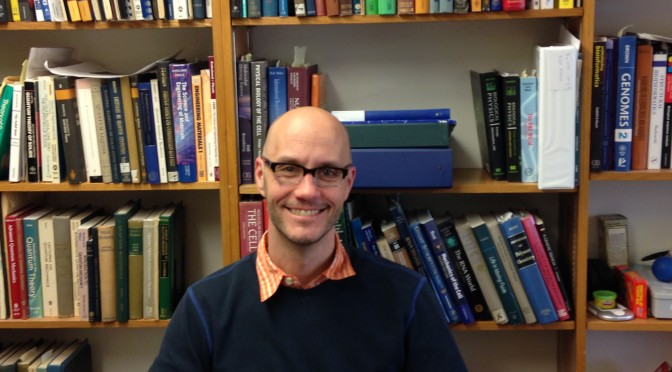By Meagan Goldman ’16
Two disciplines are better than one. That’s what Daniel Aalberts, Professor of Physics at Williams, has realized through his collaboration with biology researchers. His team, which in January published a paper in Nature, used a combination of wet lab techniques and statistical models to discover a mechanism that allows some proteins to be expressed at higher levels than others. Their findings have exciting implications for the enzyme manufacturing industry and for scientists who need to produce large quantities of proteins for their experiments.
“For this collaboration, the ability to do the computational work and the statistics, that’s in my wheelhouse,” Aalberts said. “And doing the pipetting and plate reading and all that kind of stuff is in [the biologists’] wheelhouse. And so long as we can communicate about it, we can be far more productive.”
Aalberts and his team were intrigued by a phenomenon that biologists call the redundancy of the genetic code. In order for a gene to be expressed, DNA is first copied into an intermediary form called messenger RNA (mRNA). Cells use mRNA as a template to assemble the correct protein building blocks, or amino acids. Three units of mRNA together form a codon, and each codon matches up with an amino acid. But because there exist more codons than amino acids, some amino acids have the flexibility to match up with multiple partners. In essence, this means that two different genes could produce the same protein.
The redundancy of the genetic code is an important mechanism that cells use to regulate how much protein gets made, because even when two codons code for the same amino acid, the efficiency at which they are translated often varies. This variation captured the interest of Aalberts and his team. Biologists thought that translation is slower when the sequence contains a lot of rare codons, because the machinery has a hard time locating the right components. Aalberts and his colleagues, however, found that this hypothesis didn’t correlate well with their experiments.
“So we came up with this new codon metric, identifying which of the codons seem to result in higher protein yield than others,” Aalberts said. In other words, they started looking at the amount of final product instead of the speed of translation.
What they discovered was that cell machinery just has a harder time translating some codons, regardless of how rare or common they are. When the machinery encounters a difficult codon, it sometimes stops translation altogether, and the half-baked protein gets broken down. It’s no wonder, then, that proteins containing these sequences are scarce in cells.
This new information could change the way scientists view translation. It may not be a process that always runs its full course. Rather, Aalberts and his colleagues propose a model where competition between translation and degradation determines a gene’s likelihood of making it to protein form.
As a physicist, Aalberts found these results surprising. “This is something where physicists and computer scientists sometimes have the wrong intuition,” he explained. From a physicist’s perspective, a cell should want to be maximally efficient in all processes. “But really,” Aalberts said, “it wants to manage the relative levels [of proteins].”
Using their findings, the team redesigned genes to increase translation efficiency. They have a patent on the technique and are working on commercializing it. The process has the potential to be transformative for researchers who work on proteins and for enzyme manufacturers, whose products are necessary in the detergents and drugs industries, just to name a few.
Aalberts has learned a lot from his collaborators about lab experiments and believes they have learned a lot from him about modeling and statistical analysis. “But you know, we don’t do the same things,” he said. And that’s a good thing, because the different perspectives made this project possible. “So in the end I think it is all about doing the verbs that you’re good at.”
